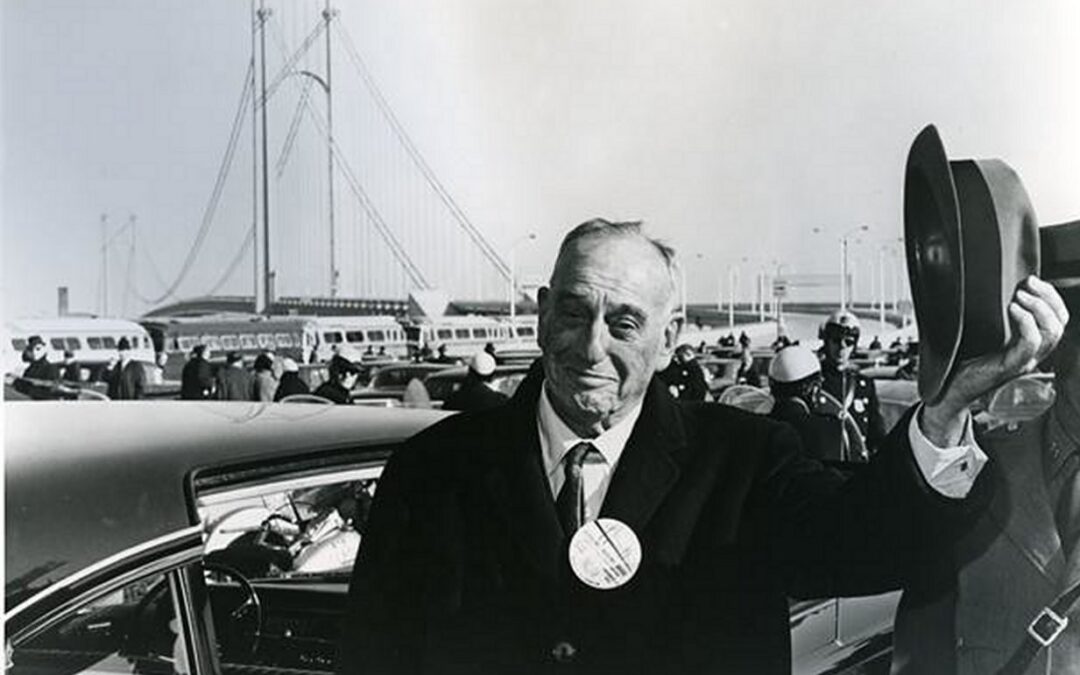For those of you who have never heard of Robert Moses, he was a city official in New York in the early part of the 20th century. A rather large Pulitzer Prize-winning book called The Powerbroker was written about his life. If you can get through the nearly 1300 pages, it’s a really good book. We can thank Robert Moses for over 400 miles of roads and over 2,000,000 acres of parks.
Robert Moses was interesting in a lot of ways. He positioned himself so that every department needed to go through him and he controlled many aspects of life in New York. Over the years he held 12 different positions in New York, some at the same time. He controlled how high the bridges were because he was a firm believer that cars were the future of cities. Moses specifically designed bridges so that they had overpasses so that buses and other forms of transportation couldn’t utilize them. He is responsible for how parking was laid out and lots of things that are part of the current infrastructure. He did a lot of good in his time, but he displaced almost 250,000 people to realize his dreams for New York. It was a high price to pay.
Cities realized some time ago that things like parking and their use of space in general, didn’t necessarily make sense. As we move forward with remote work as a potential standard for the future, cities need to rethink themselves. They need to forget a lot of what Robert Moses brought to the table from a car-based a car economy and relook at how cities function in terms of neighborhoods. They also need to think in terms of mixed-use and what cities need and not in terms of districts.
Another One Bites The Dust
With office vacancies at around 50% and crime on the rise in many areas, owners are abandoning property in many cities.
I was reading an article recently about Brian May from Queen and how he bought a chunk of land in his home city that was vacant. It now has over 100,000 trees on it and it’s referred to as May’s Wood. Cities need to start looking at their empty spaces and start creating more green spaces. Not just for environmental reasons and cooling, but for there to be reasons to go to the cities. Robert Moses took a more forced approach to creating parks. This is an opportunity to take a more mindful approach.
Modern planning values the creation and preservation of green spaces, parks, and recreational areas. These serve as essential elements for quality of life, mental health, and community engagement. Sustainable design and green building practices are integral to city planning. This includes energy-efficient buildings, renewable energy sources, stormwater management, and urban agriculture initiatives. Cities are increasingly planning for the impacts of climate change. This involves flood control measures, climate-resilient infrastructure, and policies to reduce greenhouse gas emissions.
Cars are no Longer the Future
I’m still holding out for flying cars. But the days of fossil fuel-based personal transportation are coming to an end. Electric seems to be the current flavor of choice, but there’s likely to be growth in hydrogen and ammonia-powered vehicles. Instead of prioritizing cars, contemporary city planning emphasizes diverse transportation options, such as walking, cycling, public transit, and shared mobility. Cities are working to reduce traffic congestion and air pollution while promoting healthier and more efficient modes of transportation.
Incorporating technology and data-driven decision-making is becoming more common. Smart city initiatives use data to optimize transportation, utilities, and other services, making cities more efficient and responsive to citizens’ needs.
Beyond Bureaucracy
Robert Moses developed a bureaucracy into an art form. He created rules and regulations that gave him control in a way that even if you could go around one obstacle, he controlled the other avenues as well. Moses has been gone for a few decades but The Metropolitan Transportation Authority (MTA), the New York Office of Parks, Recreation, and Historic Preservation, the New York City Housing Authority, and various other organizations still carry the marks of his involvement. All of these still serve valuable purposes, but it’s time for New York City and others to reinvent themselves.
The Draw of Cities
“If your train’s on time, you can get to work by nine and start your slaving job to get your pay”. I got to hear Randy Bachman sing Takin Care of Business recently. It’s still a great song, but the scenario about commuting is changing. We are approaching an inflection point where people may go to cities more for other reasons than work.
Mass Transit is already seeing changes in usage patterns. What used to be heavy on the weekdays, and light on the weekends has been completely flipped. Ridership during commute typical commuter hours has dropped significantly. But traffic for nights and weekends has jumped dramatically. The reason is people are coming to cities for activities and entertainment, but not necessarily work. These are the types of patterns that are likely to shape the future of cities soon.
People will either live in cities or visit cities for what they have to offer. Not because that’s where the work is. Unlike Moses, there is currently a greater appreciation for preserving historical and cultural landmarks within the urban fabric, promoting a sense of identity and continuity. Planners need to focus on building diverse and resilient economies. This includes supporting small businesses, encouraging innovation hubs, and promoting tourism and cultural initiatives. Cities will also be moving away from the centralized model and business districts and returning to pre-WWII models. Some cities are already adopting polycentric planning. This encourages the development of multiple urban centers or hubs to reduce congestion and improve access.
Hopefully, we can get it right this time. We can’t just forcibly relocate people based on one man’s vision. Public participation in the planning process needs to become standard practice. Planners need to seek input from residents, businesses, and other stakeholders. They need to ensure that developments meet the needs and desires of the community. Promoting equity in planning means addressing systemic inequalities and ensuring that vulnerable communities are not disproportionately impacted by development projects. It’s time to remake cities so everyone benefits.



